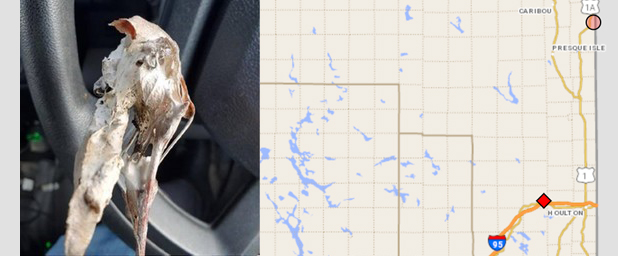|
For Immediate Release
February 12, 2021
Contact: Jim Britt
Aroostook County Browntail Moth Winter Webs Deliver Well-Timed "Heads Up" to All of Maine
AUGUSTA - The Department of Agriculture, Conservation and Forestry's Maine Forest Service (MFS) recently reported a browntail moth (BTM) winter web in Smyrna. MFS recovered a new web from Fort Fairfield earlier this week. BTM winter webs are colonies of BTM caterpillars in white silk tightly woven around a leaf or leaves in trees or shrubs. The Aroostook County discoveries serve as a literal "heads up" for Mainers. MFS asks Mainers to go Heads Up! for BTM— look up to the trees for winter webs. In areas not already documented as having high BTM populations, winter web sightings, or suspected winter webs, should be reported to MFS by emailing or using the online reporting form.
Heads Up! for BTM:
- The best time to be Heads Up! for BTM (aka joining the MFS winter 2021 BTM survey) is on a sunny day, with the sun at your back.
- Inspect the branches' tips on hardwood trees, especially oak, apple, and other fruit trees.
-
Look for shining silk tying last year's leaves to the branches. Binoculars help.
- Winter webs vary quite a bit. Sometimes they are the size of a large fist. Other times they are a single leaf without much silk.
- BTM winter webs always have white strands of woven silk holding the leaf/leaves tight to branches.
###
BTM FAQs
Q: Why is it important to know where BTM is?
A: BTM is an invasive insect that can significantly impact our quality of life. It can cause a long-lasting, painful and itchy rash in some individuals, and inhalation of the caterpillars' shed hairs can cause respiratory distress. Other people suffer few impacts from exposure. Knowing BTM's location gives us the power to decide whether and how to manage its presence.
Q: How can I manage BTM?
A: Management options include clipping and destroying the webs within reach (best done before Mid-April and always wear eye protection and cover hands and skin). Hire an arborist or contract with a licensed pesticide applicator to control populations that are out of reach.
Q: Is finding BTM in Aroostook surprising?
A: The recent detection of BTM in Smyrna and Fort Fairfield is not as surprising as it might seem. BTM webs and caterpillars were reported at least as far north as Houlton in the early 1900s.
Q: Is BTM in all parts of Maine?
A: In recent years, captured BTM appeared in traps in almost every corner of Maine. The state's northwest corner is the only exception.
Q: How does BTM move throughout the state?
A: People easily move BTM as mature caterpillars, pupae, and adults; other stages are readily carried on live trees and shrubs
Q: How did BTM end up in Maine?
A: It arrived here in the late 1800s, from Europe, on live trees and shrubs.
Q: Is BTM more of a coastal problem?
A: That was nearly true in the last outbreak, which ended in the early 2000s. MFS has reported inland populations in places like Augusta since 2007 and significant BTM populations in Bangor, beginning in 2018.
Q: Are there BTM tools and resources available to read online and download?
A: Many helpful resources, including questions and answers and tools for home- and land-owners, are available online.
Q: What is MFS doing to combat BTM?
A: First and foremost, MFS is working with communities and organizations to communicate the vital message of BTM precautions. BTM has been in Maine for over 100 years. Sadly, eradicating BTM is not possible. What is possible is being prepared to remove winter webs when one is spotted and knowing infested areas to be avoided during summer and fall.
Learn more about BTM and MFS Forest Health and Monitoring online.
 (left) Browntail moth web collected in Smyrna, ME in January 2021, (right) location of Smyrna and Fort Fairfield winter web detections. This web was found and collected by Maine Forest Service Forest Inventory staff. Images: Maine Forest Service, Maine DOT Public Map Viewer.
 In areas not already documented as having high BTM populations, winter web sightings, or suspected winter webs, should be reported to MFS by emailing or using the online reporting form.
BTM winter web.
|